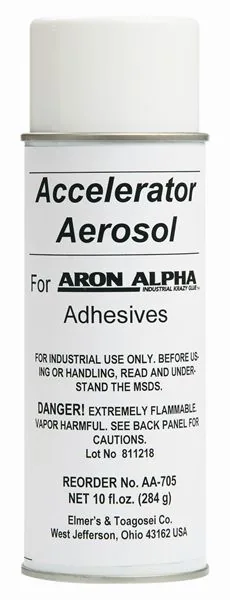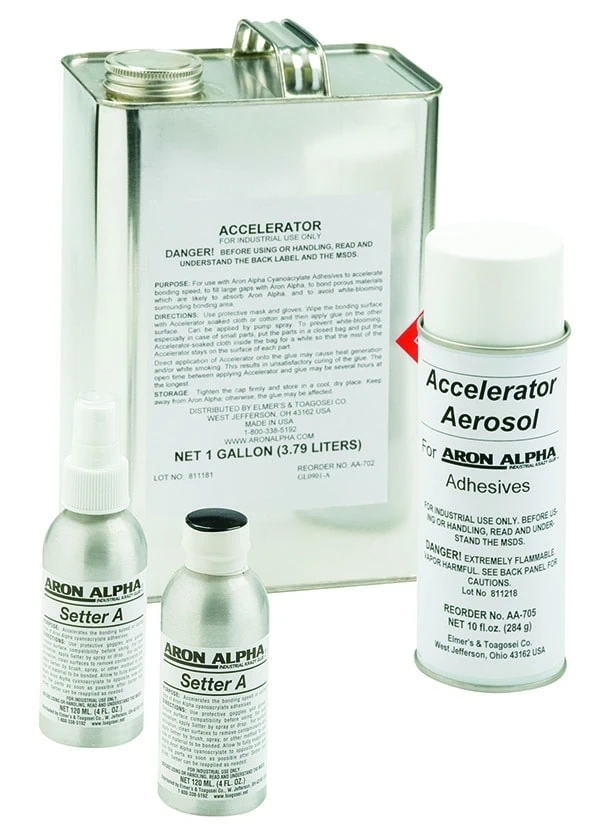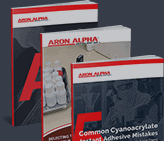Aron Alpha Cyanoacrylate Accelerators
Aron Alpha® Aerosol or Liquid Cyanoacrylate Accelerator is used where increased cure speed of cyanoacrylate instant adhesive is required. When applying the glue to one surface and spraying or brushing the other surface with a small mist or coating of the cyanoacrylate instant adhesive accelerator, the glue will bond and dry almost instantly.
The solvents used to carry the active “amine” ingredient in the setters are typically acetone, heptane or ethanol alcohol based solvents and are chosen because they flash off (evaporate) quickly and leave little residue on the bonding materials.
Accelerators are used in applications that require rapid curing of cyanoacrylate adhesives and instant fixturing seen in high speed assembly operations where bond speed is critical to the staging of the next production process procedure. Accelerators also can be used to normalize and make a manufacturing process more consistent where there are temperature and humidity swings throughout the calendar year (think cold/dry winter and hot/humid summer Midwest US climate)
Cyanoacrylate accelerators enable fast bonding times and can mitigate risks of improper or slower curing, which include:
- Blooming: Also know as frosting or chlorosis. This is the unattractive white haze that can sometimes occur when using instant glues. The residue is a byproduct of the polymerization (curing) process of instant adhesive. Once the monomer (liquid) is in vapor form, it will react with moisture in the ambient air, cure and settle out on the material around the bonding area. This usually occurs when the operator over applies (too heavy) the cyanoacrylate adhesive causing slower cure times. The cyanoacrylate accelerator eliminates this white blooming by quickly solidifying the liquid glue thus avoiding the vapor from rising around the bond line.
- Misaligned parts: Prolonged or slow curing times mean that there is more time for the bond to improperly set. During the adhesion process, the two bonded parts can be jostled, moved and put out of alignment during the manufacturing process. This can create out of conformance parts and produce unnecessary scrap or rework in a manufacturing production environment or worse become revealed at the customer’s production line causing non-compliance quality alerts.
- Poor adhesion: Porous materials may need an accelerators for the adhesive to adhere properly. These porous materials include wood, leather, and foam sponge rubber. The accelerator initiates the cure before the adhesive seeps into the porosity of these substrates.
Cyanoacrylate accelerators can:
- Reduce curing times to create an instant adhesive bond
- Push the adhesive to cure all at once
- Reduce the total amount of adhesive needed for thinner, more effective bonds
How Cyanoacrylate Instant Adhesive Accelerators Work
After instant adhesive is applied to one material’s surface, a mist or coating of cyanoacrylate instant adhesive accelerator is applied to the secondary material. This enables the glue to bond and dry almost instantly once the two surfaces are mated in the assembly process. Cyanoacrylate accelerators adds “amines” before the bonding and curing reaction. This creates a faster bond in low-moisture environments and dry, arid climates, and it also counteracts adverse conditions in areas with very low ambient humidity levels.
Accelerators can also counteract poor bonding conditions caused by oily and acidic substrates. Wood is a prime example of a substrate that can be oily, acidic, or dry. Some wood substrates possess all three of these conditions at once, which makes them a poor candidate for super glue bonds. Accelerators provide stronger adhesion without blooming (chlorosis) or a vulnerability to stress cracks.
Cyanoacrylate accelerator can be either pre-applied or post-applied after the application of the adhesive. Rapid adhesion is best achieved after the accelerator is applied. Users can also spray accelerator onto the bond seam after the initial bonding period. Spraying the exposed seam speeds up the bonding process and creates a more consistent cure throughout the joint.
The accelerator can also be sprayed onto cyanoacrylate filled gaps creating a fillets to encourage dept of cure and adhesive stability. In certain conditions, an accelerator can be brushed (pre-applied) over the substrate bonding surface prior to adhesive dispensing.
For more information about how cyanoacrylate accelerators work, check out our blog: “What You Need to Know About Cyanoacrylate Glue Accelerators & Primers”
Typical Applications that benefit from the use of Aron Alpha Cyanoacrylate Accelerators:
- Securing wires or coils to PC boards
- Mounting standoffs
- Tamper-proofing adjustable components
- Board stiffeners
- Edge guides
- Loudspeaker assembly
- Coil-to-ferrite magnet bonding
- Flash curing adhesive beads or fillets
- Cosmetic applications that require a tidy adhesive appearance
- Finishing or sealing wood
Considerations for Optimal Results
Cyanoacrylate accelerators can be highly flammable and volatile. Anyone that uses them must take care to review and adhere to local regulations regarding these solvent chemistries. Additionally, the solvent in the aerosol or liquid may degenerate plastics including ABS, polycarbonate, polystyrene, and acrylic (PMMA), causing affected surface areas to become cloudy, sticky or cause stress cracks in the plastic materials.
For best results, test all surfaces before implementing within the intended application.
Aron Alpha designs a wide range of adhesive accelerators to achieve ideal bonds. If you would like to learn more about them, check out our catalog here.







